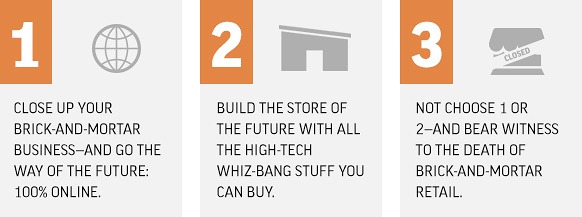Depending on how technologically inclined you are, a quick Google search of “the future of retail” can either be incredibly exciting—or incredibly unsettling.
One thing is certain: Retail is changing and will continue to change. A lot. E-commerce is growing. Shopping malls are dying. Big data is getting smarter. Smartphones (and the style of shopping that is aided by them) are proliferating. And (fortunately or unfortunately) that’s just the tip of the iceberg.
As a retailer—or someone who works with retailers—all these changes can seem like an unavoidable (and highly disruptive) tsunami of trends that will leave the classic brick-and-mortar model in the rubble. Now, throw in virtual fitting rooms, interactive store windows, line-less checkouts and individualized offers sent directly to your phone, and you might get the sense that we’re closer to Minority Report than previously thought:
Let’s come back to retailers for a minute. For someone witnessing all of these changes and developments, a retailer can get the sense that he or she has one of three options:
Fortunately, this oversimplifies things. After all, 90% (or more) of retail transactions still happen in brick-and-mortar stores, so, despite e-commerce’s rapid growth, stores definitely still matter. The key is figuring out how your stores matter to your business, your brand, and, of course, your customers—and then answering the potentially terrifying and disrupting question: “What’s the purpose of having a store?”
Let’s be clear: Asking this question, in and of itself, does not suggest that stores have no purpose. Instead, answering this question can set a course for your brand and your business in the change-heavy, uncharted retail waters ahead.
So, like any good strategic planner, I suggest we answer this question with more questions.
Let me repeat: Retail is changing and will continue to change. A lot.
And, your business is going to change, too. You will have the opportunity to incorporate technology and data into your business in ways that are difficult to even imagine right now. It’s exciting, and it will undoubtedly lead to a more efficient, pleasant and effective shopping experience for your customers.
The danger, however, is that with such tremendous change, you can lose track of what your brand stands for—and what makes it distinctive. Technology—for all its benefits—has the capacity to make a brand more generic by making an experience less personal, less emotional and less special. That’s why it’s critical—before embarking into the Brave New World of Retail—to build a solid brand foundation that guides every decision you make about your business going forward.
By understanding yourself and your brand, you’ll be much better prepared to offer an exemplary brand experience in-store—and really everywhere else.
Got that? You’re ready for question 2.
For a retailer today, this question is of utmost importance, considering that customers don’t see stores as their only point of reference for a brand anymore. This is omni-channel shopping—and, yes, your store is just one of those channels.
That’s why it’s imperative to understand how your customers (not the customers from a generic retail study) view your brand—and what they want from a store.
Consider the case of JCPenney under former CEO Ron Johnson. In trying to pursue a new type of consumer, Johnson oversaw dramatic changes in the company’s inventory selection, pricing strategy (no more discounts!), branding and store layout. The result? Johnson lasted 17 months—and Tim Calkins at Quartz succinctly concluded, “It is easier to lose your existing customers than it is to gain new ones.”
JCPenney’s customers did not want or ask for these changes—and they showed their displeasure by taking their business elsewhere.
How do your customers want to connect with you and your brand? What do they value?
Once you answer that, you’re ready for the next question.
Don’t answer this question literally. Instead, consider the following sentence from a recent Fast Company feature on Warby Parker:
For (Neil) Blumenthal, stores are not profit centers as much as marketing collateral, giant advertisements for Warby Parkers’s website. “They’re synergistic,” he says, noting that 85% of Warby retail buyers have already browsed online.
Yes, Warby Parker is selling a product (glasses), but its stores are really selling its brand.
You can also sell an experience—or expertise. In a recent NPR segment on specialized small businesses, one merchant explained why the reporter should buy a product from the merchant that he could otherwise buy on Amazon:
“The product itself is not special. I don’t like to think that I sell products. I like to think that I sell the ritual, the wisdom. My customers don’t shop here to purchase things necessarily. My customers come here to ask questions.”
In another example, an online merchant, who took advantage of a retail space rental service, called Storefront, explained in a recent New Yorker feature: “Because we’re online, we don’t have the warm and fuzzy feeling of a mom-and-pop store. It’s kind of nice to actually see our customers once in a while.”
He was, put simply, selling fuzzy feelings.
Please understand: I’m not suggesting that stores are money pits (though some are). Instead, if you have a store, it’s critical to understand its purpose. What does it need to achieve to be successful? Does it need to sell a ton of product? Does it need to educate consumers? Does it need to create brand advocates? Or just create fuzzy feelings? What’s its point?
By answering these three questions, you can ensure your brand and your stores are aligned to serve one another—and your customer.
****
Here at Full Contact, we are really excited about retail (always have been) and what its future holds. And we know the brands that will win the future of retail will not be those that think and act tactically by asking “What?” The brands that win will be those that have built strong brand foundations and, instead, ask “Why?”

